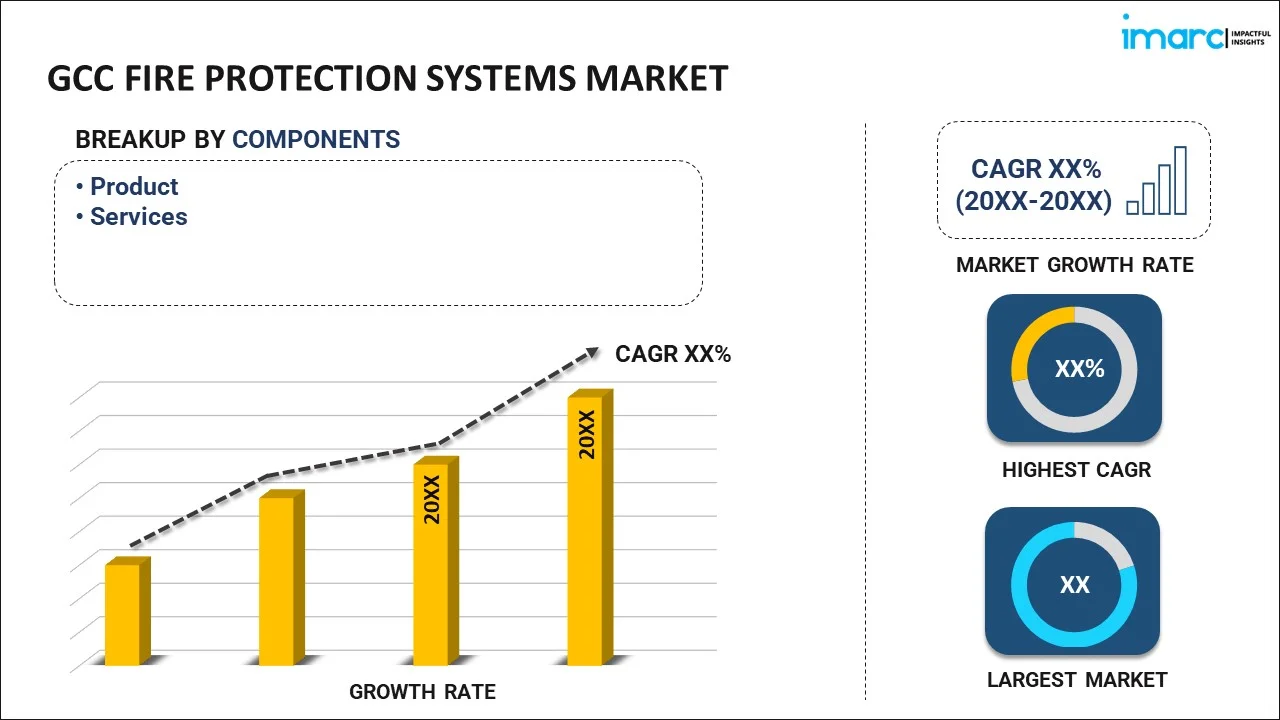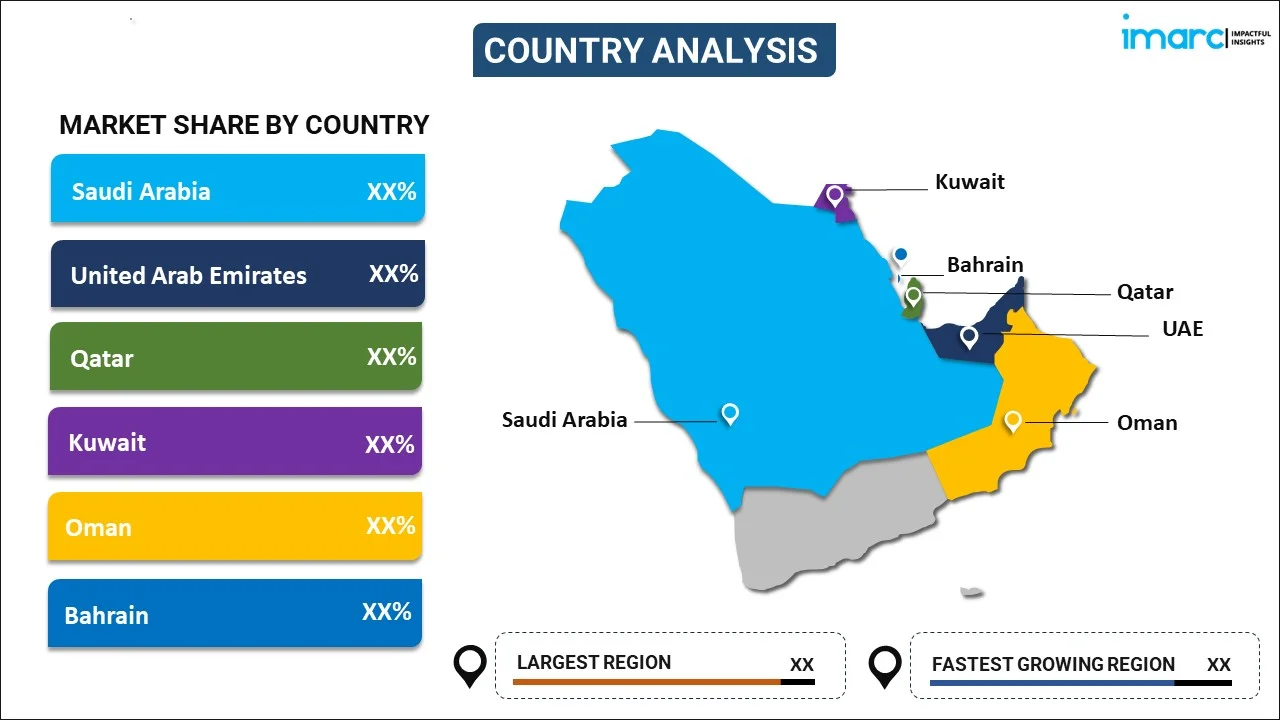
GCC Fire Protection Systems Market Report by Component (Product, Services), Type (Active Fire Protection System, Passive Fire Protection System), Application (Residential, Commercial, Industrial), and Country 2025-2033
Market Overview:
The GCC fire protection systems market size reached USD 1.3 Billion in 2024. Looking forward, IMARC Group expects the market to reach USD 2.8 Billion by 2033, exhibiting a growth rate (CAGR) of 8.6% during 2025-2033. The focus on hosting large-scale events and constructing iconic structures, the growing need for comprehensive fire safety solutions across industrial and residential locations and the integration of sensors and remote-control capabilities represent some of the key factors driving the market.
|
Report Attribute
|
Key Statistics
|
|---|---|
|
Base Year
|
2024 |
|
Forecast Years
|
2025-2033
|
|
Historical Years
|
2019-2024
|
| Market Size in 2024 | USD 1.3 Billion |
| Market Forecast in 2033 | USD 2.8 Billion |
| Market Growth Rate (2025-2033) | 8.6% |
Fire protection systems stand as a robust fortress of safety in the face of fire-related risks, encompassing an array of technologies and solutions designed to prevent, detect, and suppress fires. Fire protection systems represent a critical aspect of infrastructure development, safeguarding lives, property, and assets. These systems include a diverse range of components such as fire alarms, sprinkler systems, fire extinguishers, smoke detectors, and fire suppression systems. It encompasses a broad spectrum of solutions designed to cater to different scenarios and environments. These solutions include but are not limited to fire hydrant systems, fire pumps, fire blankets, fire doors, fire-resistant coatings, and passive fire protection measures like fire-resistant building materials. Each of these components plays a unique role in enhancing the overall fire safety infrastructure. The significance of fire protection systems lies in their ability to swiftly respond to fire incidents, curbing potential devastation and minimizing the impact on businesses, residences, and public spaces. As the GCC region continues to experience urbanization and industrial growth, the demand for advanced and reliable fire protection systems has become paramount.
GCC Fire Protection Systems Market Trends:
The GCC fire protection systems market is primarily driven by the growing need for comprehensive fire safety solutions across industrial and residential locations. Apart from this, it also prompts the integration of advanced technologies into buildings, commercial establishments, and industrial facilities, which is creating a positive market outlook. Moreover, the GCC region's focus on hosting large-scale events and constructing iconic structures necessitates state-of-the-art fire protection measures that adhere to international safety standards. Along with this, the increased emphasis on compliance and regulations has bolstered the demand for fire protection systems. Governments and regulatory bodies in the GCC are setting stringent fire safety standards, compelling businesses to invest in robust fire protection infrastructure to adhere to legal requirements and ensure the safety of occupants. This drive towards compliance aligns with the broader global trend of prioritizing safety and risk mitigation. The evolution of smart technologies and the Internet of Things (IoT) has transformed the landscape of fire protection systems. Integration of sensors, real-time monitoring, and remote control capabilities are enabling more proactive fire prevention and management. As the GCC region embraces smart cities and digitization, the demand for technologically advanced fire protection systems that provide real-time insights and remote management is gaining momentum. Other factors, including rising collaborations among leading players and extensive research and development (R&D) activities conducted by key players, are also positively influencing the market.Top of Form
GCC Fire Protection Systems Market Segmentation:
IMARC Group provides an analysis of the key trends in each segment of the GCC fire protection systems market report, along with forecasts at the regional and country levels for 2025-2033. Our report has categorized the market based on component, type, and application.
Component Insights:

- Product
- Detection
- Suppression
- Response
- Analysis
- Sprinkler System
- Services
- Engineering
- Installation
- Maintenance
- Others
A detailed breakup and analysis of the market based on the component has also been provided in the report. This includes product (detection, suppression, response, analysis and sprinkler system) and services (engineering, installation, maintenance and others).
Type Insights:
- Active Fire Protection System
- Passive Fire Protection System
The report has provided a detailed breakup and analysis of the market based on the type. This includes active fire protection system, and passive fire protection system.
Application Insights:
- Residential
- Commercial
- Industrial
The report has provided a detailed breakup and analysis of the market based on the application. This includes residential, commercial and industrial.
Country Insights:

- Saudi Arabia
- UAE
- Qatar
- Bahrain
- Kuwait
- Oman
The report has also provided a comprehensive analysis of all the major regional markets, which include Saudi Arabia, UAE, Qatar, Bahrain, Kuwait and Oman.
Competitive Landscape:
The report has also provided a comprehensive analysis of the competitive landscape in the market. Competitive analysis such as market structure, key player positioning, top winning strategies, competitive dashboard, and company evaluation quadrant has been covered in the report. Also, detailed profiles of all major companies have been provided.
GCC Fire Protection Systems Market Report Scope:
| Report Features | Details |
|---|---|
| Base Year of the Analysis | 2024 |
| Historical Period | 2019-2024 |
| Forecast Period | 2025-2033 |
| Units | Billion USD |
| Scope of the Report | Exploration of Historical and Forecast Trends, Industry Catalysts and Challenges, Segment-Wise Historical and Predictive Market Assessment:
|
| Components Covered | • Product: Detection, Suppression, Response, Analysis, Sprinkler System • Services: Engineering, Installation, Maintenance, Others |
| Types Covered | Active Fire Protection System, Passive Fire Protection System |
| Applications Covered | Residential, Commercial, Industrial |
| Countries Covered | Saudi Arabia, UAE, Qatar, Bahrain, Kuwait, Oman |
| Customization Scope | 10% Free Customization |
| Post-Sale Analyst Support | 10-12 Weeks |
| Delivery Format | PDF and Excel through Email (We can also provide the editable version of the report in PPT/Word format on special request) |
Key Questions Answered in This Report:
- How has the GCC fire protection systems market performed so far and how will it perform in the coming years?
- What has been the impact of COVID-19 on the GCC fire protection systems market?
- What is the breakup of the GCC fire protection systems market on the basis of component?
- What is the breakup of the GCC fire protection systems market on the basis of type?
- What is the breakup of the GCC fire protection systems market on the basis of application?
- What are the various stages in the value chain of the GCC fire protection systems market?
- What are the key driving factors and challenges in the GCC fire protection systems market?
- What is the structure of the GCC fire protection systems market and who are the key players?
- What is the degree of competition in the GCC fire protection systems market?
Key Benefits for Stakeholders:
- IMARC’s report offers a comprehensive quantitative analysis of various market segments, historical and current market trends, market forecasts, and dynamics of the GCC fire protection systems market from 2019-2033.
- The research study provides the latest information on the market drivers, challenges, and opportunities in the GCC fire protection systems market.
- Porter's five forces analysis assist stakeholders in assessing the impact of new entrants, competitive rivalry, supplier power, buyer power, and the threat of substitution. It helps stakeholders to analyze the level of competition within the GCC fire protection systems industry and its attractiveness.
- Competitive landscape allows stakeholders to understand their competitive environment and provides an insight into the current positions of key players in the market.
Need more help?
- Speak to our experienced analysts for insights on the current market scenarios.
- Include additional segments and countries to customize the report as per your requirement.
- Gain an unparalleled competitive advantage in your domain by understanding how to utilize the report and positively impacting your operations and revenue.
- For further assistance, please connect with our analysts.
 Inquire Before Buying
Inquire Before Buying
 Speak to an Analyst
Speak to an Analyst
 Request Brochure
Request Brochure
 Request Customization
Request Customization




.webp)




.webp)












